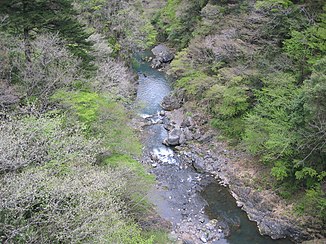Tama (river)
| Tama | ||
|
Upper reaches of the Tama from the Sakai Bridge in Okutama |
||
| Data | ||
| location | Japan . Yamanashi , Tokyo and Kanagawa Prefectures | |
| River system | Tama | |
| source | South slope of Kasatori-yama 35 ° 51 ′ 18 ″ N , 138 ° 49 ′ 31 ″ E |
|
| Source height | 1865 m | |
| muzzle | In Tokyo Bay between Tokyo (district Ōta ) and Kawasaki Coordinates: 35 ° 31 ′ 56 " N , 139 ° 46 ′ 40" E 35 ° 31 ′ 56 " N , 139 ° 46 ′ 40" E |
|
| Mouth height | 0 m | |
| Height difference | 1865 m | |
| Bottom slope | 14 ‰ | |
| length | 138 km | |
| Catchment area | 1240 km² | |
| Left tributaries | Nippara, Zambori, No. | |
| Right tributaries | Kosuge, Hirai, Aki, Yachi, Asa, Ōguri, Misawa , Hirase | |
| Big cities | Tokyo ( Setagaya and Ōta districts ), Kawasaki | |
| Medium-sized cities | Ōme , Hamura , Fussa , Akishima , Hino , Tachikawa , Kunitachi , Inagi , Chōfu , Komae | |
| Small towns | Okutama , Hinode | |
| Residents in the catchment area | approx. 4,250,000 (as of 1995) | |
| Navigable | Only in the mouth area | |
The Tama ( Japanese 多摩川 , Tama-gawa , rarely also 玉川 with the same reading) is a river on the Japanese main island of Honshū . It is 138 km long and has a catchment area of 1,240 km².
geography
The Tama rises south of the summit of the Kasatori-yama (1953 m) in the Okuchichibu Mountains in the Yamanashi prefecture . Until he entered Lake Okutama , he was named Tabagawa. From Lake Okutama in Tokyo Prefecture, it first flows as a mountain river to the east, until it turns to the southeast in the city of Ōme . It now flows through the southern part of the Kantō plain and thus one of the most densely populated areas on earth. Below the cities of Inagi and Fuchū , the Tama forms the border between Tokyo prefecture with the cities of Chōfu and Komae and the districts of Setagaya and Ōta on the left bank and Kanagawa prefecture with the city of Kawasaki on the right bank. Here shortly before the mouth, the river is also called Rokugō-gawa ( 六 郷 川 ). It flows into Tokyo Bay in the port area of Tokyo and Kawasaki . The Tokyo Haneda International Airport is located at the mouth of the river .
history

Because of its great gradient, the Tama has always been notorious for its floods. Early bridge construction fell victim to the floods again and again.
During the Edo period , the river served as a defensive line for Bakufu , which is why no bridge crossed the river between 1688 and 1874. With the Edo period, the expansion of a widely ramified canal system on the middle and lower reaches, which served agriculture ( rice cultivation ) and the water supply of the city of Edo . The dykes along the lower reaches of the river, which have existed for hundreds of years, have been systematically expanded since 1918, starting from the estuary. In 1974 a flood devastated parts of the city of Komae.
Economy, environment and social
The building boom that began in the Tokyo metropolitan area in the Meiji period led to increased mining of gravel for concrete production in the lower reaches of the Tama. As a result, the river bed sank and the river water became unusable due to the ingress of sea water. Gravel mining in the lowest section of the river was therefore prohibited in 1936.
The increasing urbanization of the river basin led to an increase in water pollution , which peaked in the 1980s. Today one tries to reconcile flood protection and ecology. In the meantime, all weirs in the Tama are equipped with fish ladders, which has made it possible for the fish species that have disappeared to return.
Hamura between the mouth and extend (partly side and partly on both sides) of the river dykes largely cross-free cycle paths .
The extensive floodplains between the dykes are used for local recreation and are partly designed as parks and sports facilities, but there are also large fallow areas as retreats for rare wild animals and plants. The Tama thus makes an important contribution to the networking of biotopes .
In the course of reporting on Typhoon Fitow in September 2007, Japanese media reported that around 700 homeless people were living in the floodplain between the dikes.
literature
- Kokudokōtsūshō Kantōchihōseibikyoku Keihinkasen Jimusho (Ed.): Mizube o arukō Tamagawa aruku, asobu, manabu handobukku 2004 . Yokohama 2004.
Web links
- Tamagawa River and basin Museum (Japanese)
- River database of the Ministry of Land, Infrastructure and Transport : Entry Tama
- Piranhas stalk Japan river - report on Al Jazeera English about Neozoon im Tama (video, English, 3 min)

